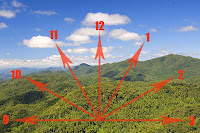.
.
 Yummy!
Yummy!
Photo: © Daniel De Granville, 2009Termites are almost unanimously considered as a pest, both in cities and in the countryside. They can cause
enormous damage in urban areas by attacking wood and even concrete structures in buildings, whereas in crops and cattle ranch pastures they can proliferate to such an extent that they bring
problems to landowners. For these reasons, termites are systematically eliminated in cities by specialized pest control companies, and in rural areas their mounds are sometimes poisoned and removed by tractors.
 Pasture taken over by termite mounds
Pasture taken over by termite mounds
in the Brazilian Savannas
Photo: © Daniel De Granville, 2009Here at home it is not too different. Every now and then we find a part of our entry gate being eaten by them, so we decided to make a “pact”: they eat my wood, I benefit from their home. This is how we created a pizza-baking oven inside a termite mound in our backyard. We had heard similar stories of this use from old-time
Pantanal folks, but without much detail. The internet also had very few information, so that we had to do it the way we thought it should be (it is worth remembering that, together with a group of friends, we built a similar oven four years ago, but unfortunately it was taken down).
 "Sorry for the inconvenience, we are
"Sorry for the inconvenience, we are
working to serve you better "
(building the first oven)
Photo: © Rakka C., 2006Enjoy the results of this new invention, that I am prone to call “ecorecycling”.
 Job done, just waiting to be officially inaugurated!
Job done, just waiting to be officially inaugurated!
Photo: © Daniel De Granville, 2009
Today’s lesson: like everything in nature, these insects also have their good and useful side. Probably the first thought that came to your mind were our beloved anteaters, who feed mainly on termites, but these bugs also perform another very important task on soil nutrient cycling. As the world famous naturalist David Attenborough mentions on this
documentary, “
probably a forest will not miss much if every human disappeared from the surface of Earth, but would sure suffer a lot if the millions of termites were eliminated from the area”.
 Ready for the pizzas!
Ready for the pizzas!
Photo: © Daniel De Granville, 2009And the help from termites is not limited to nature: besides this rustic oven, in the past it was common for Pantanal people to make the flooring in their houses with mud taken from termite mounds, sometimes mixed with the hard seeds of the Acrocomia Palm to replace gravel. I heard that nowadays engineers are studying the amazingly efficient airflow system in termite nests to come up with cooler buildings that are more energy-efficient by diminishing the demands for air-conditioners.
.
.
.









